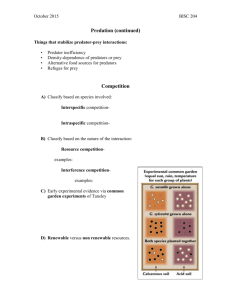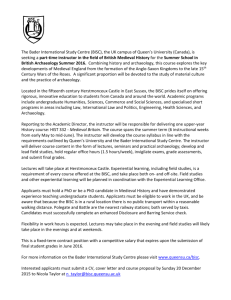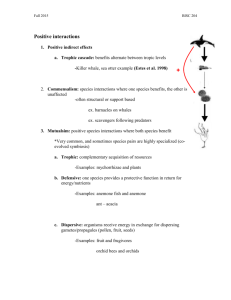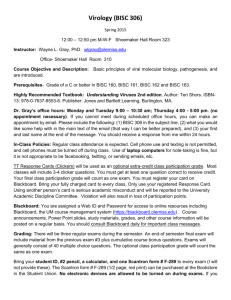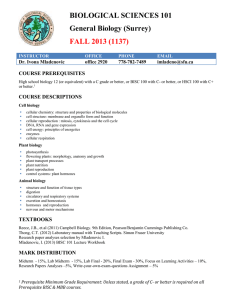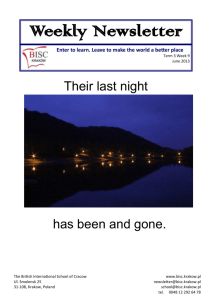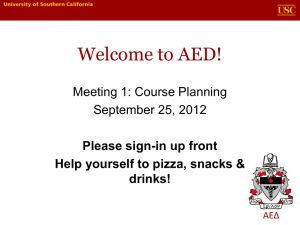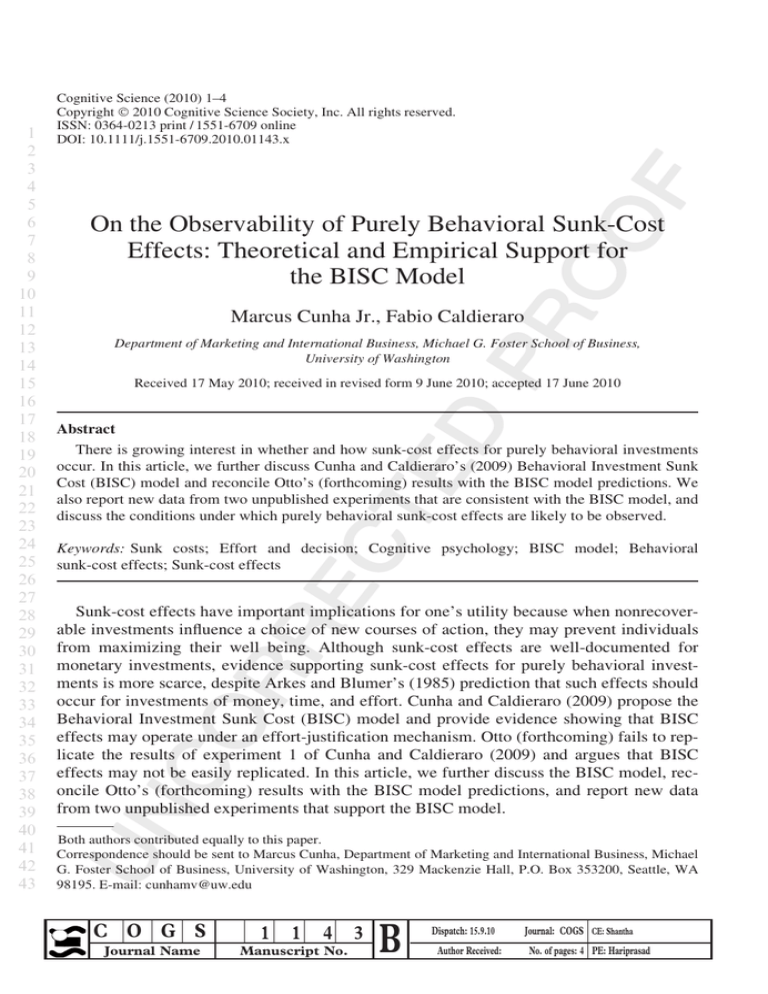
1
2
3
4
5
6
7
8
9
10
11
12
13
14
15
16
17
18
19
20
21
22
23
24
25
26
27
28
29
30
31
32
33
34
35
36
37
38
39
40
41
42
43
Cognitive Science (2010) 1–4
Copyright 2010 Cognitive Science Society, Inc. All rights reserved.
ISSN: 0364-0213 print / 1551-6709 online
DOI: 10.1111/j.1551-6709.2010.01143.x
On the Observability of Purely Behavioral Sunk-Cost
Effects: Theoretical and Empirical Support for
the BISC Model
Marcus Cunha Jr., Fabio Caldieraro
Department of Marketing and International Business, Michael G. Foster School of Business,
University of Washington
Received 17 May 2010; received in revised form 9 June 2010; accepted 17 June 2010
Abstract
There is growing interest in whether and how sunk-cost effects for purely behavioral investments
occur. In this article, we further discuss Cunha and Caldieraro’s (2009) Behavioral Investment Sunk
Cost (BISC) model and reconcile Otto’s (forthcoming) results with the BISC model predictions. We
also report new data from two unpublished experiments that are consistent with the BISC model, and
discuss the conditions under which purely behavioral sunk-cost effects are likely to be observed.
Keywords: Sunk costs; Effort and decision; Cognitive psychology; BISC model; Behavioral
sunk-cost effects; Sunk-cost effects
Sunk-cost effects have important implications for one’s utility because when nonrecoverable investments influence a choice of new courses of action, they may prevent individuals
from maximizing their well being. Although sunk-cost effects are well-documented for
monetary investments, evidence supporting sunk-cost effects for purely behavioral investments is more scarce, despite Arkes and Blumer’s (1985) prediction that such effects should
occur for investments of money, time, and effort. Cunha and Caldieraro (2009) propose the
Behavioral Investment Sunk Cost (BISC) model and provide evidence showing that BISC
effects may operate under an effort-justification mechanism. Otto (forthcoming) fails to replicate the results of experiment 1 of Cunha and Caldieraro (2009) and argues that BISC
effects may not be easily replicated. In this article, we further discuss the BISC model, reconcile Otto’s (forthcoming) results with the BISC model predictions, and report new data
from two unpublished experiments that support the BISC model.
Both authors contributed equally to this paper.
Correspondence should be sent to Marcus Cunha, Department of Marketing and International Business, Michael
G. Foster School of Business, University of Washington, 329 Mackenzie Hall, P.O. Box 353200, Seattle, WA
98195. E-mail: cunhamv@uw.edu
C O G S
Journal Name
1 1 4 3
Manuscript No.
B
Dispatch: 15.9.10
Author Received:
Journal: COGS CE: Shantha
No. of pages: 4 PE: Hariprasad
2
The BISC model predicts that the effort-induced increment in perceived utility of an initial choice (the BISC value) increases as effort increases. Thus, BISC effects depend on the
magnitude of the BISC value relative to the incentives to disregard this value (i.e., the
opportunity cost of selecting another alternative). Fig. 1 shows that when the BISC value is
not calibrated relative to the opportunity cost, equivalent magnitudes of sunk-cost effect
should be observed across levels of effort: Either most individuals are likely to experience
LOW RESOLUTION FIG
1
2
3
4
5
6
7
8
9
10
11
12
13
14
15
16
17
18
19
20
21
22
23
24
25
26
27
28
29
30
31
32
33
34
35
36
37
38
39
40
41
42
43
M. Cunha, F. Caldieraro ⁄ Cognitive Science (2010)
Fig. 1. Theory and experiment predictions.
3
M. Cunha, F. Caldieraro ⁄ Cognitive Science (2010)
1
2
3
4
5
6
7
8
9
10
11
12
13
14
15
16
17
18
19
20
21
22
23
24
25
26
27
28
29
30
31
32
33
34
35
36
37
38
39
40
41
42
43
3
sunk-cost effects or most individuals are unlikely to experience sunk-cost effects (regions A
and C of Fig. 1, respectively). However, when the opportunity cost is large enough to offset
smaller BISC values but not larger BISC values, one is likely to observe varying magnitudes
of BISC effects across levels of effort investment (region B of Fig. 1).
Otto’s (forthcoming) experiments failed to capture differences in perceived satisfaction
with the initial choice as a function of effort, thus failing to activate the effort-justification
mechanism underlying the BISC model effect (a puzzling result given how well effort-justification is established in the literature of cognitive dissonance). Hence, it is not surprising
that Otto was not able to observe the BISC effects. In fact, his results are consistent with
region C of Fig. 1, which predicts no BISC effects because the opportunity cost offsets both
levels of effort investment (i.e., BISC values).
In Otto’s (forthcoming) experiments, the predicted relationship between effort and satisfaction is not statistically significant across effort conditions. However, it is encouraging to
see that, within the greater-effort condition in experiments 2 and 3, there was a positive correlation between decision time and initial satisfaction. This suggests that the BISC value
operated within the greater-effort condition, and that the effort manipulation may not have
been optimally calibrated for the population of the experiments. It is possible that, among
other factors, the use of more meaningful choice scenarios, or of alternative measures to
capture the positive BISC value across different populations and contexts, may facilitate the
observability of BISC effects.
To further support the BISC model, we report two unpublished experiments. The first experiment was similar to experiment 1 in Cunha and Caldieraro (2009) with the key difference that
the four attribute ratings were presented as digits (e.g., ‘‘7’’; lesser effort) versus words (e.g.,
‘‘seven’’; greater effort). Participants were MBA students from Santa Clara University who
computed the average rating for eight products with the target product featuring a rating of 7.5.
The ratings for the low and high opportunity cost products were 7.6 and 8.2, respectively. The
second experiment was a variant of experiment 2 from Cunha and Caldieraro (2009). Participants were undergraduate business students from the University of Washington who made
actual choices of chocolate bars. Participants computed the overall value of chocolate bars by
adding the ratings of four attributes (creaminess, aftertaste, cocoa grade, and melting balance)
for 4 (lesser effort) versus 12 (greater effort) chocolate bars with the target bar featuring a rating of 31. The ratings for the low and high opportunity cost bars were 32 and 37, respectively.
At the end of the experiment, participants could choose between their initial choice of chocolate bar and the opportunity cost bar (M&M’s M’Azing or Hershey’s chocolate bar, counterbalanced daily). Measures were taken on 7-point scales with greater ratings indicating greater
perceived effort, satisfaction, and likelihood-to-switch (choice proportions in experiment 2).
Results, shown in Table 1, replicate the findings in Cunha and Caldieraro (2009).
We suspect that, relative to laboratory contexts, BISC effects may be more pronounced in
real life situations because of the greater meaningfulness of the choices and motivation to
invest effort. Consistent with this rationale, advertisers and manufacturers pay a premium for
placing their ads and their products in locations that can help consumers reach a decision after
considering a few options. This could be explained not only by the fact that processing of additional pieces of information is cognitively taxing, but also because once an individual finds a
4
1
2
3
4
5
6
7
8
9
10
11
12
13
14
15
16
17
18
19
20
21
22
23
24
25
26
27
28
29
30
31
32
33
34
35
36
37
38
39
40
41
42
43
M. Cunha, F. Caldieraro ⁄ Cognitive Science (2010)
Table 1
Xxxxxxxxxxxx
2
Greater Effort
Experiment 1 (n = 63)
Perceived effort
3.88 (1.73)
Initial satisfaction
5.24 (1.37)
Likelihood to switch
4.29 (1.93)
(small opportunity cost)
Likelihood to switch
5.88 (1.63)
(large opportunity cost)
Interaction term
Experiment 2 (n = 178)
Perceived effort
3.48 (1.59)
Initial satisfaction
4.99 (1.43)
Proportion who switched 30.2%
(small opportunity cost)
Proportion who switched 71.7%
(large opportunity cost)
Interaction term
Lesser Effort
Statistic
BF [log(BF)]
2.97 (1.52)
3.83 (1.66)
5.57 (1.09)
t(61) = 2.22, p = .03
t(61) = 3.68, p < .001
F(1,59) = 5.11, p = .03
0.12 [)2.12]
0.05 [)3.00]
0.57 [)0.56]
5.50 (1.41)
F(1,59) = 0.46, p = .50
2.76 [1.02]
F(1,59) = 4.36, p = .04
2.93 (1.44)
4.52 (1.24)
71.4%
t(176) = 2.42, p = .02
t(176) = 2.35, p = .02
v2(1) = 14.23, p < .001
74.5%
v2(1) = 0.10, p = .75
0.26 [)1.35]
0.35 [)1.05]
<0.001 [<)100]
6.16 [1.82]
b = 1.61, SE = 0.67,
Wald v2(1) = 5.84, p = .02
Note. Values for the Greater and Lesser Effort conditions are the average ratings on a 7-point scale, unless
data are choice proportions. Standard deviations for ratings are presented in parentheses. Bayes Factors (BF) and
Log Bayes Factors computed according to the Savage-Dickey procedure using WinBUGS. Both the statistics
and the Bayes Factors support the predicted differences in satisfaction with the choice (BISC value) and the
hypothesized BISC effects.
satisfactory option, the attractiveness of slightly superior alternatives decreases as a function
of the additional utility stemming from the effort invested in reaching an initial decision.
We stress that a condition for replication of BISC effects is that effort needs to be translated into incremental utility for the initial choice. As it can be inferred from our theorizing,
perceptions of the BISC value and opportunity cost can easily vary across populations and
contexts. Thus, lack of calibration between the BISC value and opportunity costs may lead
to null effects. Nevertheless, we are confident that the BISC model is a parsimonious theory
to investigate BISC effects, as evidenced by the experiments reported in this article and in
Cunha and Caldieraro (2009). We encourage researchers to further develop manipulations
and measures that accurately capture the BISC value.
References
Arkes, H. R., & Blumer, C. (1985). The psychology of sunk cost. Organizational Behavior and Human Decision
Processes, 35, 124–140.
Cunha, M. Jr., & Caldieraro, F. (2009). Sunk-cost effects on purely behavioral investments. Cognitive Science,
33, 105–113.
Otto, R. A. (forthcoming). Three Attempts to Replicate the Behavioral Sunk-Cost Effect: A Note on Cunha and
1
Caldieraro (2009). Cognitive Science, ?????, ?????–?????.
Author Query Form
Journal:
COGS
Article:
1143
Dear Author,
During the copy-editing of your paper, the following queries arose. Please respond to these by marking up your proofs with the necessary changes/additions. Please write your answers on the query
sheet if there is insufficient space on the page proofs. Please write clearly and follow the conventions
shown on the attached corrections sheet. If returning the proof by fax do not write too close to the
paper’s edge. Please remember that illegible mark-ups may delay publication.
Many thanks for your assistance.
Query reference
Query
Q1
AUTHOR: Please update reference Otto (forthcoming).
Q2
AUTHOR: Please provide caption for Table 1.
Q3
AUTHOR: Figure 1 has been saved at a low resolution of 99 dpi. Please resupply at 600 dpi. Check
required artwork specifications at http://authorservices.wiley.com/submit_illust.asp?site=1
Remarks
Proof
Correction
Marks
MARKED
PROOF
Please correct and return your proofs using the proof correction marks below. For a more
Please correct and return this set
detailed look at using these marks please reference the most recent edition of The Chicago
Manual
of the
Style
and correction
visit them marks
on theshown
Web at:
http://www.chicagomanualofstyle.org/home.
Please use
proof
below
for all alterations and corrections. If you
html
wish to return your proof by fax you should ensure that all amendments are written clearly
Instruction
Instructiontotoprinter
typesetter
Leave unchanged
Insert in text the matter
indicated in the margin
Delete
Substitute character or
substitute part of one or
more word(s)
Change to italics
Change to capitals
Change to small capitals
Change to bold type
Change to bold italic
Change to lower case
‘superior’ character
Insert superscript
Insert subscript
Insert ‘inferior’ character
Insert full stop
Insert comma
Textual mark
under matter to remain
New
matterbyfollowed
followed
by
new by
followed
new
or
matter
through
single
character,
rule
underline
through
single
character,
rule
oror
underline
through
single
character,
rule
or
underline
or
through
all
characters
deleted
through
allthrough
characters
to to
bebe
deleted
all characters
to be deleted
through letter or
through characters
under matter to be changed
under matter to be changed
under matter to be changed
under matter to be changed
under matter to be changed
B
Encircle matter to be changed
through character or
where required
(As above)
(As above)
or
new character or
new characters
or
under character
under character
e.g.
e.g.overorcharacter
e.g.
over character
(As above)
Insert single quotation marks
Insert double quotation marks
Insert hyphen
Start new paragraph
Transpose
(As above)
(As above)
Close up
linking
Insert or substitute space
between characters or words
Reduce space between
characters or words
Marginal mark
or
or
(As above)
characters
through character or
where required
between characters or
words affected
and/or

